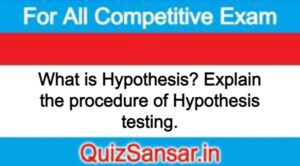
What is Hypothesis? Explain the procedure of Hypothesis testing.
What is Hypothesis? Explain the procedure of Hypothesis testing.
Ans.
Ordinarily, when one talks about hypothesis, one simply means a mere assumption or some supposition to be proved or disproved. But for a researcher hypothesis is a formal question that he intends to resolve. Thus a hypothesis may be defined as a proposition or a set of proposition set forth as an explanation for the occurrence of some specified group of phenomena either asserted merely as a provisional conjecture to guide some investigation or accepted as highly probable in the light of established facts. Quite often a research hypothesis is a predictive statement, capable of being tested by scientific methods, that relates an independent variable to some dependent variable. For example, consider statements like the following ones:
“Students who receive counselling will show a greater increase in creativity than students not receiving counselling” Or
“The automobile A is performing as well as automobile B.”
These are hypothesis capable of being objectively verified and tested. Thus, we may conclude that a hypothesis states what we are looking for and it is a proposition which can be put to a test to the determine its validity.
Characteristics of Hypothesis:
Hypothesis must possess following characteristics :
(i) Hypothesis should be clear and precise. If the hypothesis is not clear and precise, the inferences drawn on its basis cannot be taken as reliable.
(ii) Hypothesis should be capable of being tested. In a swamp of untestable hypothesis, many a time the research programmes have bogged down. Some prior study may be done by researcher in order to make hypothesis a testable one. A hypothesis “is testable if other deductions can be made from it which, in turn, can be confirmed or disproved by observation.”
(iii) Hypothesis should state relationship between variables, if it happens to be a relational hypothesis.
(iv) Hypothesis should be limited in scope and must be specific. A researcher must remember that narrower hypothesis are . generally more testable and he should develop such hypothesis.
(v) Hypothesis should be stated as far as possible in most simple terms so that the same is easily understandable by all concerned. But one must remember that simplicity of hypothesis has nothing to do with its significance.
(vi) Hypothesis should be consistent with most known facts i.e., it must be consistent with a substantial body of established facts. In other words, it should be one which judges accept as being the most likely.
(vii) Hypothesis should be amenable to testing within a reasonable time. One should not use even an excellent hypothesis, if the same cannot be tested in reasonable time for one cannot spend a life-time collecting data to test it.
(viii) Hypothesis must explain the facts that gave rise to the need for explanation. This means that by using the hypothesis plus other known and accepted generalizations, one should be able to deduce the original problem condition. Thus hypothesis must actually explain what it claims to explain; it should have empirical reference.
Procedure for Hypothesis Testing
To test a hypothesis means to tell (on the basis of the data the researcher has collected) whether or not the hypothesis seems to be valid. In hypothesis testing the main question is: whether to accept the null hypothesis or not to accept the null hypothesis? Procedure for hypothesis testing refers to all those steps that we undertake for making a choice between the two actions e., rejection and acceptance of a null hypothesis. The various steps involved in hypothesis testing are stated below:
(i) Making a formal statement: The step consists in making a formal statement of the null hypothesis (Ho) and also of the alternative hypothesis (Ha). This means that hypotheses should be clearly stated, considering the nature of the research problem. For instance, Mr. Mohan of the Civil Engineering Department wants to test the load bearing capacity of an old bridge which must be more than 10 tons, in that case he can state his hypotheses as under :
Null hypothesis Ho : µ = 10 tons
Alternative Hypothesis Ha : µ > 10 tones
Take another example. The average score in an aptitude test administered at the national level is 80. To evaluate a state’s education system, the average score of 100 of the state’s students selected on random basis was 75. The state wants to know if there is a significant difference between the local scores and the national scores. In such a situation the hypotheses may be stated as under:
Null hypothesis Ho : µ = 80
Alternative Hypothesis Ha : µ ≠ 80
The formulation of hypothesis is an important step which must be accomplished with due care in accordance with the object and nature of the problem under consideration. It also indicates whether we should use a one-tailed test or a two-tailed test. If Ha is of the type greater than (or of the type lesser than), we use a one-tailed test, but when Ha is of the type “whether greater or smaller” then we use a two-tailed test.
(ii) Selecting a significance level: The hypothesis are tested on a pre-determined level of significance and as such the same should be specified. Generally, in practice, either 5% level or 1% level is adopted for the purpose. The factors that affect the level of significance are: (a) the magnitude of the difference between sample means; (b) the size of the samples; (c) the variability of measurements within samples; and (d) whether the hypothesis is directional or non-directional (A directional hypothesis is one which predicts the direction of the difference between, say, means). In brief, the level of significance must be adequate in the context of the purpose and nature of enquiry.
(iii) Deciding the distribution to use: After deciding the level of significance, the next step in hypothesis testing is to determine the appropriate sampling distribution. The choice generally remains between normal distribution and the t-distribution. The rules for selecting the correct distribution are similar to those which we have stated earlier in the context of estimation.
(iv) Selecting a random sample and computing an appropriate value: Another step is to select a random sample(s) and compute an appropriate value from the sample data concerning the test statistic utilizing the relevant distribution. In other words, draw a sample to furnish empirical data.
(v) Calculation of the probability: One has then to calculate the probability that the sample result would diverge as widely as it has from expectations, if the null hypothesis were in fact true.
(vi) Comparing the probability: Yet another step consists in comparing the probability thus calculated with the specified value for α, the significance level. If the calculated probability is equal to or smaller than the α value in case of one-tailed test (and α/2 in case of two-tailed test), then reject the null hypothesis (i.e., accept the alternative hypothesis), but if the calculated probability is greater, then accept the null hypothesis. In case we reject Ho, we run a risk of (at most the level of significance) committing an error of Type I, but if we accept Ho, then we run some risk (the size of which cannot be specified as long as the Ho happens to be vague rather than specific) of committing an error of Type II.






